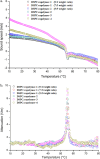Deciphering the Lipid-Random Copolymer Interactions and Encoding Their Properties to Design a Hybrid System
- PMID: 38797979
- PMCID: PMC11190979
- DOI: 10.1021/acs.langmuir.4c00278
Deciphering the Lipid-Random Copolymer Interactions and Encoding Their Properties to Design a Hybrid System
Abstract
Lipid/copolymer colloidal systems are deemed hybrid materials with unique properties and functionalities. Their hybrid nature leads to complex interfacial phenomena, which have not been fully encoded yet, navigating their properties. Moving toward in-depth knowledge of such systems, a comprehensive investigation of them is imperative. In the present study, hybrid lipid/copolymer structures were fabricated and examined by a gamut of techniques, including dynamic light scattering, fluorescence spectroscopy, cryogenic transmission electron microscopy, microcalorimetry, and high-resolution ultrasound spectroscopy. The biomaterials that were mixed for this purpose at different ratios were 1,2-dioctadecanoyl-sn-glycero-3-phosphocholine and four different linear, statistical (random) amphiphilic copolymers, consisting of oligo(ethylene glycol) methyl ether methacrylate as the hydrophilic comonomer and lauryl methacrylate as the hydrophobic one. The colloidal dispersions were studied for lipid/copolymer interactions regarding their physicochemical, morphological, and biophysical behavior. Their membrane properties and interactions with serum proteins were also studied. The aforementioned techniques confirmed the hybrid nature of the systems and the location of the copolymer in the structure. More importantly, the random architecture of the copolymers, the hydrophobic-to-hydrophilic balance of the nanoplatforms, and the lipid-to-polymer ratio are highlighted as the main design-influencing factors. Elucidating the lipid/copolymer interactions would contribute to the translation of hybrid nanoparticle performance and, thus, their rational design for multiple applications, including drug delivery.
Conflict of interest statement
The authors declare no competing financial interest.
Figures







Similar articles
-
Unveiling the Performance of Co-Assembled Hybrid Nanocarriers: Moving towards the Formation of a Multifunctional Lipid/Random Copolymer Nanoplatform.Pharmaceutics. 2024 Sep 13;16(9):1204. doi: 10.3390/pharmaceutics16091204. Pharmaceutics. 2024. PMID: 39339240 Free PMC article.
-
Development of Hybrid DSPC:DOPC:P(OEGMA950-DIPAEMA) Nanostructures: The Random Architecture of Polymeric Guest as a Key Design Parameter.Polymers (Basel). 2023 Apr 22;15(9):1989. doi: 10.3390/polym15091989. Polymers (Basel). 2023. PMID: 37177137 Free PMC article.
-
Spontaneously formed redox- and pH-sensitive polymersomes by mPEG based cytocompatible random copolymers.J Colloid Interface Sci. 2017 Sep 1;501:22-33. doi: 10.1016/j.jcis.2017.04.034. Epub 2017 Apr 12. J Colloid Interface Sci. 2017. PMID: 28432913
-
New Linear and Star-Shaped Thermogelling Poly([R]-3-hydroxybutyrate) Copolymers.Chemistry. 2016 Jul 18;22(30):10501-12. doi: 10.1002/chem.201601404. Epub 2016 Jun 27. Chemistry. 2016. PMID: 27345491
-
Lipid-polymer hybrid nanoparticles as a new generation therapeutic delivery platform: a review.Eur J Pharm Biopharm. 2013 Nov;85(3 Pt A):427-43. doi: 10.1016/j.ejpb.2013.07.002. Epub 2013 Jul 17. Eur J Pharm Biopharm. 2013. PMID: 23872180 Review.
Cited by
-
Unveiling the Performance of Co-Assembled Hybrid Nanocarriers: Moving towards the Formation of a Multifunctional Lipid/Random Copolymer Nanoplatform.Pharmaceutics. 2024 Sep 13;16(9):1204. doi: 10.3390/pharmaceutics16091204. Pharmaceutics. 2024. PMID: 39339240 Free PMC article.
References
-
- Zhang L. I.; Zhang L. Lipid-polymer hybrid nanoparticles: Synthesis, characterization and applications. Nano LIFE 2010, 01 (01n02), 163–173. 10.1142/S179398441000016X. - DOI
MeSH terms
Substances
LinkOut - more resources
Full Text Sources

